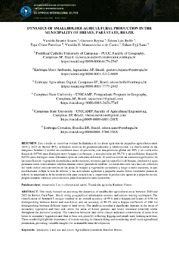Dynamics of smallholder agricultural production in the municipality of Breves, Pará state, Brazil.
Dynamics of smallholder agricultural production in the municipality of Breves, Pará state, Brazil.
Author(s): SOARES, V. B.; SILVA, G. B. S. da; BOLFE, E. L.; PARREIRAS, T. C.; CASTRO, V. H. M. e de; SANO, E. E.
Summary: This study focused on assessing the dynamics of smallholder agricultural areas between 2019 and 2023 in Breves, Pará State, Brazil, using geographical information systems and remote sensing techniques. The classification of Sentinel-2 images resulted in an overall accuracy of 99% and a Kappa coefficient of 0.98 for distinguishing between forest and non-forest, and an accuracy of 89.7% and a Kappa coefficient of 0.86 for distinguishing between different types of land cover. The analysis revealed a significant increase in the areas of secondary vegetation and bare soil, while the areas of forest, pasture, and water remained relatively stable throughout the period of analysis. The transition between land cover classes indicated a conversion of areas from forest to secondary vegetation and then to bare soil, possibly reflecting logging and small-scale farming activities. These results highlight the importance of remote sensing in characterizing and monitoring small-scale agricultural production, providing valuable insights for sustainable rural development.
Publication year: 2024
Types of publication: Paper in annals and proceedings
Unit: Embrapa Environment
Observation
Some of Embrapa's publications are published as ePub files. To read them, use or download one of the following free software options to your computer or mobile device. Android: Google Play Books; IOS: iBooks; Windows and Linux: Calibre.
Access other publications
Access the Agricultural Research Database (BDPA) to consult Embrapa's full library collection and records.
Visit Embrapa Bookstore to purchase books and other publications sold by Embrapa.

